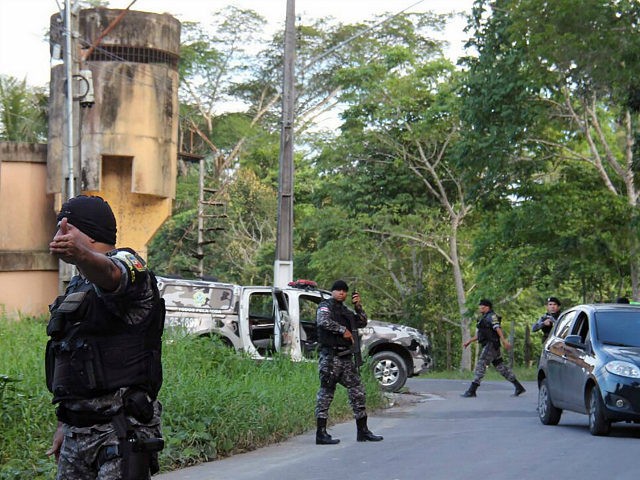Brazilian police have yet to recapture over 100 inmates who escaped from two northern prisoners in riots on New Year’s Day and appear ill-equipped to rapidly resolve the institutional decay that allowed the riots to occur in the first place.
The Spanish newswire organization EFE reports that, out of 184 prisoners who escaped the Anisio Jobim Prison Complex of Manaus (Compaj) and Antonio Trindade Penal Institute (Ipat) on the morning of January 1, Brazilian police have only managed to recapture 70 inmates. Another 114 remain on the loose. Police also increased the death toll during the Compaj riot, with the total number of dead at 60, following the discovery of decaying bodies in a remote area of the prison last Sunday.
The Compaj riot began in part as an attack by the Familia do Norte (FDN) gang on the nation’s largest drug gang, the Primeiro Comando da Capital (PCC), with inmates beheading and disemboweling members of the PCC. A week later, in another prison, PCC members killed 33 FDN members in retaliation, cutting their hearts out of their bodies and leaving a similarly bloody trail of bodies.
Brazilian officials have boosted the number of federal military police in Amazonas state, where the riots occurred, by at least 100 officers, while Amazonas governor Jose Melo has repeatedly demanded more federal help. His police resources, he lamented Sunday, were “at their physical and psychological limit.”
Among those still on the loose is Brayan Bremer, a prisoner serving a sentence for robbery who grew to national prominence after he posted selfies on his Facebook account following his flight from prison. Bremer has since become an internet sensation and the subject of his very own mobile app game: “Brayan Break,” where players must navigate the prisoner to freedom.
Bremer’s parents, along with the parents of many other fugitives, have kept a vigil in front of the prison, hoping to hear of their relative. “He left, but I don’t know if he is alive or dead,” his sister told Brazilian outlet UOL.
Residents of Manaus, the capital of Amazonas, live in fear of these inmates attacking them or committing more crimes. Adding to their fears is the news that at least one former Compaj inmate attempted to rob a bus this week but was shot to death by police. According to the regional newspaper Em Tempo, the prisoner refused to return to Compaj “because he was afraid of dying” following the bloody riot.
Police appeared to have little control over the prison residents at Compaj. A sweep of common areas in the prison following the riot turned up hundreds of illegal items, from scissors to knives to wires to drugs. Amazonas fired the head of Compaj, José Carvalho da Silva, on Tuesday, after evidence surfaced that he had accepted bribes from FDN members which allowed them to smuggle weapons and drugs into the prison. Two prisoners accused Carvalho of threatening them for having complained to higher management about his permissive behavior towards the FDN.
The FDN appears to be seeking to expand its drug trafficking capabilities in a direct challenge to the PCC, the largest gang in Brazil. Police also found evidence within Compaj of plans for an even bigger attack on PCC members, including a bomb plot.
In addition to potential bribery, Brazil’s prison system suffers gross overpopulation, which the NGO Human Rights Watch said in a report this week can be largely traced to anti-drug laws that target users with similar severity as they do traffickers. According to Human Rights Watch, Brazil’s prison population increased 85 percent in the past decade following the passage of the new anti-drug law.

COMMENTS
Please let us know if you're having issues with commenting.